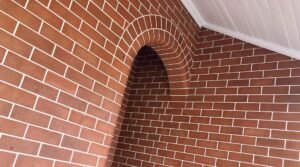If you live in Toronto or the Greater Toronto Area (GTA) and enjoy spending time outdoors, you might be thinking about adding a fire pit to your backyard. Fire pits are great for staying warm, cooking food, and creating a cozy atmosphere. But if you have a pergola, you might be wondering: Is it safe to put a fire pit under a pergola?
The short answer is: It depends. While it is possible to have a fire pit under a pergola, there are important safety considerations to keep in mind. In this blog, we’ll discuss the risks, safety tips, and alternatives to help you make the best decision for your outdoor space.
Table of Contents
ToggleWhat is a Pergola?
A pergola is an outdoor structure with an open roof, usually made of wood or metal. It has vertical posts that support crossbeams and an open lattice design. Pergolas are often used to provide shade, define outdoor spaces, and add beauty to a backyard. They are not fully enclosed, which allows air and light to pass through.
Risks of Putting a Fire Pit Under a Pergola
While a pergola can create a beautiful setting for a fire pit, there are some risks you need to be aware of:
- Fire Hazard: The most obvious risk is the potential for a fire. Pergolas are often made of wood, which can catch fire if it gets too hot or if sparks fly from the fire pit. Even metal pergolas can become dangerously hot.
- Smoke and Heat: Fire pits produce smoke and heat, which can get trapped under the pergola’s roof. This can make the area uncomfortable and even dangerous, especially if the pergola is low or has a solid roof.
- Damage to the Pergola: Over time, the heat and smoke from the fire pit can damage the pergola’s materials. Wood may become discolored or warped, and metal may rust or weaken.
- Local Regulations: In Toronto and the GTA, there may be local bylaws or fire codes that restrict the use of fire pits, especially under structures like pergolas. Always check with your local government before installing a fire pit.
Safety Tips for Using a Fire Pit Under a Pergola
If you decide to put a fire pit under your pergola, follow these safety tips to reduce the risks:
- Choose the Right Fire Pit: Not all fire pits are the same. For use under a pergola, consider a gas or propane fire pit instead of a wood-burning one. Gas fire pits produce less smoke and sparks, making them safer for covered areas.
- Keep a Safe Distance: Make sure the fire pit is placed at least 10 feet away from the pergola’s posts and roof. This will help prevent the structure from getting too hot or catching fire.
- Use a Fireproof Mat: Place a fireproof mat or pad under the fire pit to protect the ground and prevent heat from damaging the pergola’s floor.
- Install a Spark Screen: If you’re using a wood-burning fire pit, always use a spark screen to prevent embers and sparks from flying out.
- Check the Height of the Pergola: A taller pergola with an open roof design is safer for a fire pit because it allows heat and smoke to escape more easily. If your pergola is low or has a solid roof, it’s best to avoid using a fire pit underneath.
- Keep a Fire Extinguisher Nearby: Always have a fire extinguisher, bucket of sand, or garden hose nearby in case of an emergency.
- Monitor the Fire: Never leave a fire pit unattended. Always supervise the fire and make sure it is completely extinguished before leaving the area.
Alternatives to Using a Fire Pit Under a Pergola
If you’re concerned about the risks of using a fire pit under a pergola, here are some alternatives to consider:
- Move the Fire Pit: Place the fire pit in an open area away from the pergola. This will allow you to enjoy the fire pit safely while still being close to the pergola.
- Use an Outdoor Heater: Outdoor heaters are a safer option for staying warm under a pergola. They don’t produce flames or sparks, so they are less of a fire hazard.
- Install a Chiminea: A chiminea is a type of outdoor fireplace that is designed to contain the fire and direct smoke upward. It can be a safer option for use near a pergola, but you should still keep it at a safe distance.
- Create a Fire Pit Area: Designate a separate area in your backyard for the fire pit. You can use stones, bricks, or pavers to create a fire pit zone that is away from any structures.
Check Local Regulations
Before installing or using a fire pit, it’s important to check the local regulations in your area. In Toronto and the GTA, there are rules about where and how you can use fire pits. For example:
- Fire pits must be at least 10 feet away from buildings, fences, and other structures.
- Only clean, dry wood or propane can be used as fuel.
- Fire pits must be supervised at all times.
Failing to follow these rules can result in fines or even the removal of your fire pit. Always check with your local government or fire department to make sure you are following the rules.
Conclusion
Putting a fire pit under a pergola can be safe if you take the necessary precautions. However, it’s important to understand the risks and follow safety guidelines to protect yourself, your property, and your loved ones. Choose the right type of fire pit, keep it at a safe distance, and always monitor the fire.
If you’re unsure about using a fire pit under your pergola, consider alternatives like outdoor heaters or a separate fire pit area. And don’t forget to check local regulations to make sure you’re following the rules.
By taking these steps, you can enjoy the warmth and beauty of a fire pit while keeping your outdoor space safe and comfortable. Stay warm and have fun!















